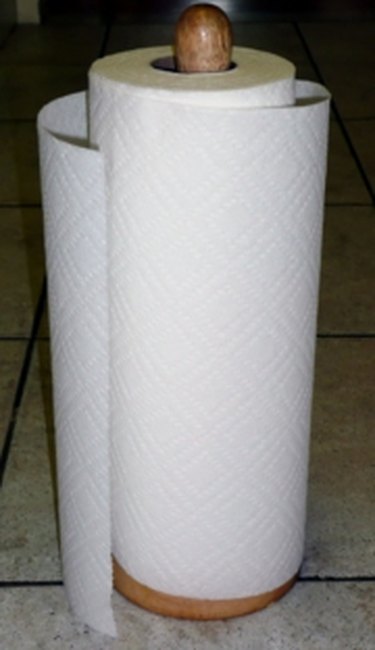Things You'll Need
Scissors
Large kitchen knife
Wooden spatulas
Measuring jug (one quart size)
Colander
Vegetable shredder
Crushed vegetable fibers such as celery, wheat,
bamboo or straw.
Large stewing pot
Soup spoon & measuring spoons
2 plastic pails
Powdered geletin
Corn starch
Commercial fabric dyes
Mallet
Mould and deckle frame
Felts
Razor blades
Glass cylinder
Wax crayons
Apron
Electric blender
Hot plate/press

Paper towels have multiple uses and serve as convenient towels that are used to clean up spills, dust, wipe away messes and dry your hands. Paper towels are made from wood products, recycled paper or raw material such as vegetable fibers. Making paper towels can be a little complex, which is why they are mostly manufactured. But you can try to create your own paper towels at home with a little ingenuity and lots of materials. Most of the equipment you need can be found in your kitchen.
Step 1
Begin collecting waste paper from trash bins or office trash cans, you can ask local businesses for their shredded paper, which is great to begin with. You may also want to add vegetable fibers such as celery, wheat, straw or bamboo, then cut fibers into fine strands and tear paper into tiny pieces. Place all the paper and fibers into a large pot and cover with boiling water, then add a caustic solution to remove any impurities.
Video of the Day
Step 2
Place the pot on the stove and simmer for two to five hours, then drain the liquid and repeat the same process again. The paper materials should become a fatty pulp of mass and any dirt or impurities should separate itself from the fatty pulp. Remove any of these impurities with a strainer and carefully mix the pulp with clean water and place into a blender to shred the crude mixture.
Step 3
Paper towels are often bleached during this process to make the towel whiter by adding a small amount of bleach to the paper pulp or the use of colored fabric dyes are used to produce color in the towel. Some brands contain a low level of resin or binder (glue that keeps the fibers from falling apart when they become wet.) This is what paper towel manufacturers call "wet strength," or "Bounty tough," as consumers are familiar with.
Step 4
Expensive paper towel brands contain an additive that will make the paper towel feel "soft" rather than the "Bounty tough." While blending, the pulp mass should become a semi-liquid fibrous material, then the creamy pulp is poured into a tub and more water is added for consistency. Then the pulp is ready to be placed into casting or moulding with the deckle frame attached.
Step 5
The deckle frame is fit over the mould to prevent excess pulp from spilling out and the mould and deckle frame is given a shake, two ways to intertwine and crisscross the fibers. Patterns of shapes such as squares, diamonds or other images are often imprinted into the paper towel to help hold the moisture in. Most paper towel rolls are manufactured with two layers of thin paper and the more layers the towels have, the stronger the paper towel.
Step 6
After a thin piece of pulp and felt has been formed on the mould, the sheet of towel is allowed to drain for a short time, then the process is repeated, removing of the felt, stacking up piles of these sheets, until the desired strength of paper towel is formed. The mould is lifted and the piles are now ready to be pressed and squeezed of any excess water.
Step 7
The paper is then placed in the open air to dry slowy. Once the thin sheets of paper are dried, they are cut into different sizes. Sizing may be done with one tablespoon of corn starch or unflavored gelatin, or any other starchy substances. The sheets of paper are placed in trays of gelatin sizing, then the process of pressing and drying procedure is repeated over and over again until the paper is dried completely.
Step 8
Continue the series of steps for the paper forming process of pressing to remove water between the rolls and felts, then drying to achieve a certain moisture level, and the calendering process where the paper is compacted and smoothed as it is rolled or cut into sheets. Another method for paper towel making is to use toilet paper with liquid starch, a bowl, screen, cookie sheet, towel, and a heavy book. While the processing method is the same, the materials used are less.
Tip
Research, research, research, before attempting these procedures to gain maximum knowledge on how to effectively produce paper. Remember there are two distinct varieties of paper towels. Domestic, which are your common, household, everyday use kitchen towels or rolls, and Institutional,which are tougher brands made to be placed in public bathrooms in metal and plastic dispensers. Paper towels can be made from vegetable fibers, wheat, potatoes, beans, iris, celery, gladioli, or reeds, each giving a different color, texture, and even scent - but you must choose which is more effective for the paper towel's intricate designs. An 1970s EPA study concluded that using one ton of 100 percent recycled paper saves 4,100 kwh of energy and 7,000 gallons of water. That same study also concluded recycled paper keeps 60 pounds of pollution from forming in the air and saves 3.3 cubic yards of landfill space. Also one ton of recycled paper saves approximately 17 trees.
Warning
Recycled paper can actually be more expensive to manufacture. Recycled paper is the easiest form of paper to use in the paper process, but needs to be washed and bleached with a processed chlorine substance. Newsprint and glossary magazines do not make very good paper.
Video of the Day